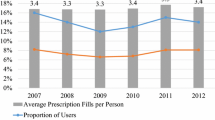Abstract
BACKGROUND
Although four-dollar programs ($4 per 30-day supply for selected generic drugs) have become important options for seniors to obtain affordable medications, little is known about access to these programs and the characteristics of those who use them.
OBJECTIVES
We quantify access to $4 programs based on driving distance; evaluate factors affecting the program use and potential cost-savings associated with switching to $4 programs in Medicare.
DESIGN
Observational study.
SETTING
US Medicare Part D data, 5% random sample, 2007
PARTICIPANTS
347,653 elderly beneficiaries without Medicaid coverage or low-income subsidies.
MAIN MEASURES
We evaluated how use of $4 programs was affected by driving distance to the store and the beneficiary’s demographic and socioeconomic status, insurance coverage, health status, comorbidities, and medication use. For those who did not use the $4 programs, we calculated potential savings from switching to $4 generics.
KEY RESULTS
Eighty percent of seniors in Medicare Part D filled prescriptions for generic drugs that were commonly available at $4 programs. Among them, only 16.3% filled drugs through $4 programs. Beneficiaries who lived in poor areas, had less insurance, more co-morbidities, and used more drugs and lived closer to $4 generic retail pharmacies, were more likely to use these programs. Blacks were less likely to use the program relative to Whites (15.0% vs. 16.4%; OR = 0.75, 95% CI 0.71–0.80). While 53.2% of nonusers would save by switching to $4 program after incorporating travelling costs, 58% of those who could save would have net annual out-of-pocket savings of less than $20.
CONCLUSIONS
The take-up rate of $4 programs was low in 2007 among Medicare beneficiaries. As more stores offer $4 programs and increasing numbers of drugs become generic, more beneficiaries could potentially benefit, as could the Medicare program.


Similar content being viewed by others
References
Wal-Mart Stores Inc. Affordable prescription program. http://walmartstores.com/healthwellness/8247.aspx. Accessed May 4, 2011.
Target.com. Target 4 dollar listing. http://sites.target.com/site/en/health/page.jsp?contentId=PRD03-004319. Accessed January 10, 2010.
Kaiser Family Foundation. Prescription Drug Trends. http://kff.org/rxdrugs/3057.cfm. Accessed February 18, 2010.
Kaiser Family Foundation. Medicare prescription drug plans in 2010 and key changes over five years: summary of findings. 2010; http://www.kff.org/medicare/upload/8096.pdf. Accessed September 1, 2011.
Zhang Y, Zhou L, Gellad WF. Potential savings from greater use of $4 generic drugs. Arch Intern Med. 2011;171(5):468–9.
Kaiser Family Foundation. Health care on a budget: the financial burden of health spending by Medicare households. http://kff.org/medicare/upload/8171.pdf. Accessed April 26, 2011.
Bonito A, Bann C, Eicheldinger C, Carpenter L. Creation of New Race-Ethnicity Codes and Socioeconomic Status (SES) Indicators for Medicare Beneficiaries. Final Report. Sub-Task 2. (Prepared by RTI International for the Centers for Medicare and Medicaid Services through an interagency agreement with the Agency for Healthcare Research and Policy, under Contract No. 500-00-0024, Task No. 21). http://www.ahrq.gov/qual/medicareindicators/medicareindicators.pdf. Accessed March 16, 2010.
Elixhauser A, Steiner C, Harris DR, Coffey RM. Comorbidity measures for use with administrative data. Med Care. 1998;36(1):8–27.
Centers for Medicare & Medicaid Services. Centers for Medicare & Medicaid Services Prescription Drug Hierarchical Condition Category (RxHCC) Model Software. 2010; http://www.cms.hhs.gov/MedicareAdvtgSpecRateStats/06_Risk_adjustment.asp. Accessed February 3, 2010.
Eisenberg JM, Power EJ. Transforming insurance coverage into quality health care: voltage drops from potential to delivered quality. JAMA. 2000;284(16):2100–7.
AAA Association Communication. Your driving costs. http://www.aaaexchange.com/Assets/Files/20073261133460.YourDrivingCosts2007.pdf. Accessed April 12, 2011.
Centers for Medicare & Medicaid Services. Medicare Prescription Drug Benefit Manual, Chapter 14 Coordination of Benefits, Page 19. Baltimore, MD, USA 2008.
Choudhry NK, Shrank WH. Four-Dollar Generics — Increased Accessibility, Impaired Quality Assurance. N Engl J Med. 2010;363(20):1885–7.
ACKNOWLEDGMENTS
The RAND University of Pittsburgh Health Institute and the Clinical and Translational Science Institute: Translating Research into Practice Program. This project was supported in part by the RAND–University of Pittsburgh Health Institute (RUPHI), a formal collaboration between the RAND Corporation, RAND Health, and the University of Pittsburgh School of the Health Sciences. This publication was made possible by grant UL1 RR024153 from the National Center for Research Resources, a component of the National Institutes of Health (NIH), and NIH Roadmap for Medical Research. During the study period, Dr. Zhang was also supported by NIMH RC1 MH088510 and AHRQ R01 HS018657.
Conflict of Interest
Dr. Gellad has received an honorarium from Vindico Medical Education for preparation of a continuing medical education (CME) activity focused on improving medication adherence. Drs. Zhang and Lave were investigators for a contact (2008–2009) to evaluate the effects of high-deductible health plans funded by Highmark Inc., which sells Part D plans.
Author information
Authors and Affiliations
Corresponding author
Rights and permissions
About this article
Cite this article
Zhang, Y., Gellad, W.F., Zhou, L. et al. Access to and Use of $4 Generic Programs in Medicare. J GEN INTERN MED 27, 1251–1257 (2012). https://doi.org/10.1007/s11606-012-1993-9
Received:
Revised:
Accepted:
Published:
Issue Date:
DOI: https://doi.org/10.1007/s11606-012-1993-9




